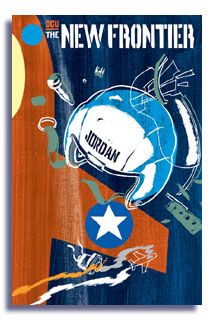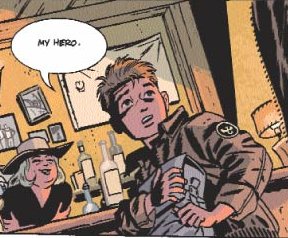| Everything
Old Is New Again
DC: The
New Frontier #1
story and art: Darwyn Cooke
Darwyn
Cooke's latest dabbling in the playpen of the DC Universe
works on many levels.
From
its title, the book hearkens back to a time when DC was absolutely,
unquestionably, top dog in the comics game. (Never mind the
Steely Dan soundtrack that is inexplicably running in the
back of my head.) National Periodicals was the new
frontier in comics. Sure, in the sixties Marvel captured the
imaginations of college students, but it was DC that set those
imaginations free in the first place, with what, in hindsight,
was the beginning of the Silver Age.
Since
those days, storytelling styles have flip-flopped a few times,
and Cooke fuses a few together. His art betrays his time working
on Batman: The Animated Series (itself a callback to
the Fleischer Superman cartoons), but that just helps
set the mood. Surprisingly, realism stands side by side with
the optimism and heart-on-its-sleeve nobility that characterized
fifties' pop culture. And like James Robinson's classic The
Golden Age, DC: The New Frontier makes a few
nods to continuity pre- and post-eighties rewrites.
Superman,
Batman, and Wonder Woman all exist in their Golden Age incarnations,
with, predictably enough, the brightly-costumed ones having
sworn loyalty oaths to the government. The rest of the so-called
"Mystery Men" disappeared in the face of HUAC, with hints
of dark fates for a couple. But they're all really just window
dressing, nods to what the fans expect while Cooke accomplishes
his apparent goal with this issue: drawing a bridge between
the mystery men and the later superheroes with the characters
and features that should have held readers' interests.
Subtitling
this first issue "Our Fighting Forces" (a classic DC war title),
Cooke offers up a final fate for The Losers far more satisfying
than the bizarre one-shot of the mid-eighties. From this comes
the seeds of Task Force X, which eventually morphs into the
Suicide Squad, in an adventure set on a prehistoric island.
Dinosaurs and army men, such stuff as young boys' dreams are
made on, collide with great splendor and pathos. In recent
years, writers (okay, mostly Chuck Dixon) have revisited "The
War That Time Forgot," but it hasn't been this fun in quite
a while.
Though
not yet making a clear connection to his first chapter, Cooke
shifts to a vignette with a young boy hoping to meet real-life
test pilot Chuck Yeager. If you can't figure out who the kid
is, you may not belong here, but trust that the character
Cooke builds here has a more palatable motivation than he
has been allowed in the past two decades.
In fact,
all the characterization has snap to it. A little older than
we're used to seeing, Lois Lane shows up, confident and a
bit brassy. No longer a "girl reporter," she carries herself
like Rosalind Russell, accompanied by a Jimmy Olsen on his
way to being a veteran war photographer.
It may
strike some as too coincidental that their paths cross with
a character destined for big things, but it works in context.
Heck, they even end up being only two degrees away from one
of the future Challengers of the Unknown. Too closely entwined?
Nah. It's just fun.
Yet Cooke
throws in a heartbreaking ending, withheld from critics in
advance and forcing us to buy a final copy on the stands.
(Not only did the ploy work, but …no regrets here about it,
except maybe a perhaps too high $6.95 cover price.) Those
last few moments again serve as great motivations for characters
we think we know, without any fantastical moments. Cooke may
not yet be at the "super" part, but he definitely has respect
for the heroes.
With
that respect is also a healthy dose of wonder, something we
don't get enough of in comics anymore. And like Marvel's Ultimate
Fantastic Four, it almost seems a shame that this will
lead into costumes and superpowers, because the story of these
ordinary people doing extraordinary things is compelling enough.
And if
I haven't made it clear, it's also just fun.
Rating:

|







